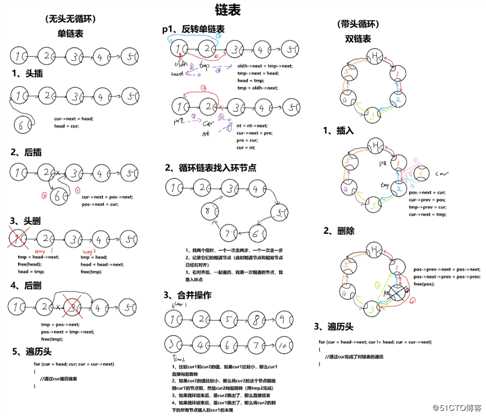标签:strong 就是 str 双链表 tmp png 循环 结束 rev
单向链表(无头无循环)cur->next=head;
head=cur;2.后插
cur->next=pos->next;
pos->next=cur;3.头删
tmp=head->next;
free(head);
head=tmp;4.后删
tmp=pos->next;
pos->next=tmp->next;
free(tmp);5遍历头
for(cur=head;cur;cur=cur->next)
{
//通过cur遍历链表
}6.反转单链表
<1>
oldhead->next=tmp->next;
tmp->next;=head;
head=tmp;
tmp=oldhead->next;<2>
nt=nt->next;
cur->next==pre;
pre=cur;
cur=nt;7.循环链表找入环节点
(1)找两个指针,一个一次走一步,一个一次走两步
(2)记录他们的相遇节点,此时相遇节点和起始节点已经右对齐
(3)右对齐后,一起遍历,找第一次相遇的节点,就是入环节点
双链表(带头循环)
1.插入操作
pos->next=cur;
cur->prev=pos;
tmp->prev=cur;
cur->next=tmp;2.删除操作
pos->prev->next=pos->next;
pos->next->prev=pos->prev;
free(pos);3.遍历操作
for(cur->head->next;cur!=head;cur=cur->next)
{
//cur进行遍历
}4.合并操作
1.比较cur1和cur2的值,如果1比较小,那么cur1直接向后跳转
2.如果2的值比较小,那么将2的这个节点前插到1的节点前面,然后2向后跳转
3.如果循环结束后,2跳出,那么直接结束
4.如果循环结束后,1跳出,那么将2的剩余所有节点插入到1的末尾

标签:strong 就是 str 双链表 tmp png 循环 结束 rev
原文地址:https://blog.51cto.com/14232799/2422502